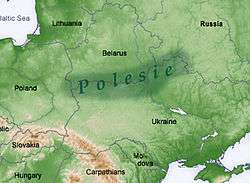Polesia
Polesia, Polesie or Polesye (Belarusian: Палессе Paliessie, Ukrainian: Полісся Polissia or Polisia, Polish: Polesie [pɔˈlɛɕɛ], Russian: Поле́сье Poles'e [pɐˈlʲesʲɪ]) is a natural and historical region starting from the farthest edges of Central Europe and into Eastern Europe, stretching from parts of Eastern Poland, touching similarly named Podlasie, straddling the Belarus–Ukraine border and into western Russia.[1]
Polesia Палессе, Полісся Polesie | |
|---|---|
Natural and historical region | |
 Ubort river near the city of Olevsk (Zhytomyr Oblast, Ukraine) | |
 Polesia marked in dark green | |
| Countries | Belarus, Poland, Russia and Ukraine |
Extent
One of the largest forest areas on the continent, Polesia is located in the south-western part of the Eastern-European Lowland, the Polesian Lowland. On the western side, Polesia originates at the crossing of the Bug River valley in Poland and the Pripyat River valley of Western Ukraine.[2] The swampy areas of central Polesia are known as the Pinsk Marshes (after the major local city of Pinsk). Large parts of the region were contaminated after the Chernobyl disaster and the region now includes the Chernobyl Exclusion Zone and Polesie State Radioecological Reserve, named after the region.
Name
The names Polesia/Polissia/Polesye, etc. may reflect the Slavic root les, which means "forest", and the Slavic prefix po-, which means "on", "in" or "along".[3] Inhabitants of Polesia are called Polishchuks.
The term is not related to "Poland", "Polish," "Pole", etc., which is derived ultimately from Old Slavic pole, "field."[4]
History
In the ancient times, the areas of today's western and west-central Polesia were inhabited by the people of the Milograd culture, the Neuri [5].
In the late middle ages part of the Grand Duchy of Lithuania, following it into the Polish–Lithuanian Commonwealth (1569), Polesia was largely part of Poland in the 1921-39 period when the country's largest provinces bore that name.[1] Polesia has rarely been a separate administrative unit. However, there was a Polesie Voivodeship during the Second Polish Republic, as well as a Polesia Voblast in Byelorussian SSR. From 1931 to 1944, it was explicitly mentioned as constituent part of the short-lived (Byzantine Rite) Ukrainian Catholic Apostolic Exarchate of Volhynia, Polesia and Pidliashia.[6] Since the end of World War II, the region of Polesie or Polesia encompasses areas in eastern Poland, southern Belarus, northwestern Ukraine, and southwestern Russia.
Geography
Polesia is a marshy region lining the Pripyat River (Pripyat Marshes) in Southern Belarus (Brest, Pinsk, Kalinkavichy, Gomel), Northern Ukraine (in the Volyn, Rivne, Zhytomyr, Kiev and Chernigov Oblasts), and partly in Poland (Lublin) and Russia (Bryansk). It is a flatland within the watersheds of the Western Bug and Prypyat rivers. The two rivers are connected by the Dnieper-Bug Canal, built during the reign of Stanislaus II of Poland, the last king of the Polish-Lithuanian Commonwealth.
Notable tributaries of the Pripyat are the Horyn, Stokhod, Styr, Ptsich, and Yaselda rivers. The largest towns in the Pripyat basin are Pinsk, Stolin, Davyd-Haradok. Huge marshes were reclaimed from the 1960s to the 1980s for farmland. The reclamation is believed to have harmed the environment along the course of the Pripyat.
This region suffered severely from the Chernobyl disaster. Huge areas were polluted by radioactive elements. The most polluted part includes the Chernobyl Exclusion Zone and the adjacent Polesie State Radioecological Reserve. Some other areas in the region are considered unsuitable for living as well.[7]
Tourism
The Polish part of the region includes the Polesie National Park (Poleski Park Narodowy), established 1990, which covers an area of 97.6 square kilometres (37.7 sq mi). This and a wider area adjoining it (up to the Ukrainian border) make up the UNESCO-designated West Polesie Biosphere Reserve, which borders a similar reserve (the Shatskiy Biosphere Reserve) on the Ukrainian side. There is also a protected area called Pribuzhskoye-Polesie in the Belarusian part of the region.
The wooden architecture structures in the region were added to the UNESCO World Heritage Tentative List on 30 January 2004 in the Cultural category.[8]
See also
- Museum of Ukrainian home icons
- Radomysl Castle
- Polesian Lowland
- UNESCO World Heritage Centre
- Western Polesie
Further reading
- Пазинич В. Походження Поліських озер та параболічних дюн
- Пазинич В.Г. Происхождение Полесских озер и параболических дюн
- Zeitschrift für Ostmitteleuropaforschung, Heft 3/2019: Polesia: Modernity in the Marshlands. Interventions and Transformations at the European Periphery from the Nineteenth to the Twenty-first Century Online: Bd. 68 Nr. 3 (2019): Polesia: Modernity in the Marshlands. Interventions and Transformations at the European Periphery from the Nineteenth to the Twenty-first Century | Zeitschrift für Ostmitteleuropa-Forschung
References
- "Polesie". University at Buffalo, New York. Polish Academic Information Center. Archived from the original on 7 September 2016. Retrieved 2 May 2014.
- Alicja Breymeyer. "Presentation of West Polesie Transboundary Biosphere Reserve (Belarus/Poland/Ukraine)". Nomination Form prepared in Warsaw, Kiev and Minsk by National UNESCO-MAB Committees, and introduced to UNESCO in a May 2007 Nomination. West Polesie.org. Archived from the original on 2 May 2016. Retrieved 2 May 2014.
- Compare Mould, R. F. (2000). Chernobyl Record: The Definitive History of the Chernobyl Catastrophe. Bristol, UK: Institute of Physics Publishing. ISBN 0-7503-0670-X.
- Weinryb, Bernard Dov (24 July 1973). "The Jews of Poland: A Social and Economic History of the Jewish Community in Poland from 1100 to 1800". Jewish Publication Society – via Google Books.
- David Asheri, Alan B. Lloyd, Aldo Corcella, A commentary on Herodotus Books I-IV , edited by Oswyn Murray, Alfonso Moreno, Oxford University Press, Oxford 2007, p. 589
- "Apostolic Exarchate of Volhynia, Polesia and Pidliashia (Ukrainian Rite)". GCatholic.
- "Zoning of radioactively contaminated territory of Ukraine according to actual regulations". ICRIN. 2004. Retrieved 25 April 2012.
- "Worship wooden architecture (17th -18th centuries) in Polesye - UNESCO World Heritage Centre". Whc.unesco.org. 30 January 2004. Retrieved 13 January 2013.
External links
| Wikimedia Commons has media related to Polesia. |